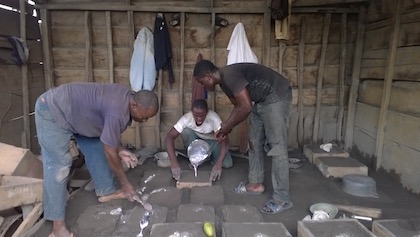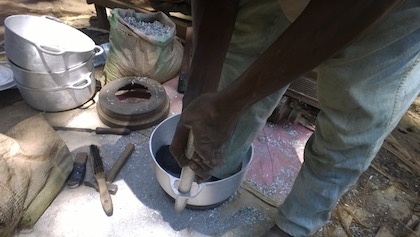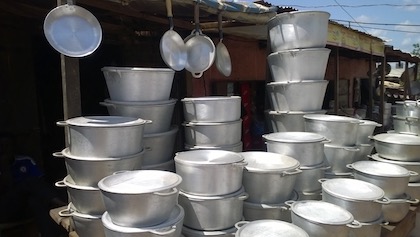Hazardous Cookware
Scrap Metal Used to Make Cookware Contaminates Food
Multiple studies from around the world show high exposures to lead and other toxic metals from artisanal aluminum cookware made from scrap metal.

Radiators and other car parts are melted down for making aluminum cookware.
(Photo courtesy of © 2020 MUNTAKA CHASANT / MUNTAKA.COM.)
This cookware is common throughout Africa, Asia and parts of South America and is made from recycled scrap metal including automobile and computer parts, cans, and other industrial debris. Unlike industrial-sourced aluminum cookware, these are not anodized and have no protective coating.
While this informal industry has significantly increased local metal recycling opportunities, it is often conducted with open pit fires in poor urban areas without electricity, water or any pollution controls. As the informal sector has grown in most low and middle-income countries, this cottage industry has also expanded. Over time, this aluminum cookware has been incorporated into cultural cooking norms in many countries.
Despite the important economic opportunity provided by this niche recycling industry, these workers are likely exposed to high concentrations of heavy metals and particulates.

Molten metal is prepared for making cookware.
(Photo courtesy of © 2020 MUNTAKA CHASANT / MUNTAKA.COM.)
Contamination from Cooking
Multiple studies of locally made aluminum cookware obtained in more than 20 countries have shown that routine cooking can result in the leaching of significant concentrations of metals into food. These products are widely used and remain a significant source of exposure to metals including:
- Aluminum
- Lead
- Cadmium
- Arsenic

Metal is poured into sand molds to make aluminum cookware.
One study that included testing cookware from ten countries found the highest lead levels in cookware from Vietnam including one pot that released 2,800 times more lead than California’s Maximum Allowable Dose Level (MADL) of 0.5 micrograms per day. From the 42 samples of aluminum cookware tested, more than one-third pose a lead exposure hazard. The cookware also released significant levels of aluminum, arsenic, and cadmium. The researchers also found levels of aluminum on average were six times greater than WHO dietary guidelines and significant concentrations of cadmium leached from more than one-third of the cookware tested.
Most studies simulated cooking by boiling acidic solutions in the cookware and measuring the lead extracted in solution. Some studies tested for levels of aluminum and other metals in samples of cooked foods. The largest such study involved the testing of 276 food samples from Benin, Mali, Cameroon, and Nigeria cooked in artisanal aluminum cookware. Results were compared to the same foods cooked in stainless-steel cookware. Samples were tested for aluminum, arsenic, cadmium, mercury, and lead. Maximum aluminum concentrations were 17 times higher in foods cooked in artisanal aluminum pots than for the same food prepared in stainless steel. Lead levels were 21 times greater than when prepared in the stainless steel cookware.

Finished cookware is filed and polished before being sold.
Levels of aluminum, arsenic, and lead reported in these studies are often many times greater than guidance issued by the UN Food and Agricultural Organization and the U.S. Food and Drug Administration (FDA). In 2018, the FDA reduced the maximum allowed daily dietary intake of lead for children to 3 micrograms per day (µg/day). There are regulatory limits for allowable levels of lead ranging up to 1.5 mg/kg, and cadmium up to 1.0 mg/kg, in food in the European Union, which were often exceeded in the studies cited below. The World Health Organization (WHO) and the U.S. Centers for Disease Control (CDC) have determined that there is no safe level of exposure to lead.

Locally made aluminum cookware is sold in markets throughout Africa and Asia.
This previously unrecognized lead exposure source has the potential to be of much greater public health significance than lead paint or other well-known sources that are common around the world. The presence of lead in food cooked in these pots may be one contributing factor to the ongoing lead poisoning epidemic. These studies support the need to regulate the lead content of non-anodized aluminum cookware.
Published studies documenting harmful exposures from aluminum cookware:
Al Zubaidy, E. A., Mohammad, F. S., & Bassioni, G. (2011). Effect of pH, salinity and temperature on aluminum cookware leaching during food preparation. International Journal of Electrochemical Science, 6(12), 6424-6441.
Al Juhaiman, L. A. (2012). Estimating aluminum leaching from aluminum cookware in different vegetable extracts. International Journal of Electrochemical Science, 7(8), 7283-7294.
Ankar-Brewoo, G., Darko, G., Abaidoo, R., Dalsgaard, A., Johnson, P. N., Ellis, W., & Brimer, L. (2020). Health risks of toxic metals (Al, Fe and Pb) in two common street vended foods, fufu and fried-rice, in Kumasi, Ghana. Scientific African, e00289.
Gimou, M. M., Pouillot, R., Charrondiere, U. R., Noël, L., Guérin, T., & Leblanc, J. C. (2014). Dietary exposure and health risk assessment for 14 toxic and essential trace elements in Yaoundé: the Cameroonian total diet study. Food Additives & Contaminants: Part A, 31(6), 1064-1080.
Habimaana, Samuel; Gumisiriza, Hannington; Birungi, Grace. (2022). Trace Metal Leaching from Cookware Locally Fabricated from Scrap Metal: A Case Study of Ntungamo District, Uganda. American Journal of Analytical Chemistry.
Jitaru, P., Ingenbleek, L., Marchond, N., Laurent, C., Adegboye, A., Hossou, S. E., ... & Eyangoh, S. (2019). Occurrence of 30 trace elements in foods from a multi-centre Sub-Saharan Africa Total Diet Study: Focus on Al, As, Cd, Hg, and Pb. Environment international, 133, 105197.
Mohammad, F. S., Al Zubaidy, E. A. H., & Bassioni, G. (2011). Effect of aluminum leaching process of cooking wares on food. International Journal of Electrochemical Science, 6(1), 222-230.
Osborn, E. L. (2009). Casting aluminium cooking pots: labour, migration and artisan production in West Africa's informal sector, 1945–2005. African Identities, 7(3), 373-386.
Radford, A., Harari, J., Northway, S., & Kroop, B. (2014). Potential Causes of Failure in an Aluminum Sand-Cast Pot from Zambia. Heart Failure.
Street, R. A., Mathee, A., Tanda, S., Hauzenberger, C., Naidoo, S., & Goessler, W. (2020). Recycling of scrap metal into artisanal cookware in the informal sector: A public health threat from multi metal exposure in South Africa. Science of The Total Environment, 699, 134324.
Weidenhamer, J. D., Chasant, M., & Gottesfeld, P. (2022). Metal exposures from source materials for artisanal aluminum cookware. International Journal of Environmental Health Research, 1-12.
Weidenhamer, J. D., Fitzpatrick, M. P., Biro, A. M., Kobunski, P. A., Hudson, M. R., Corbin, R. W., & Gottesfeld, P. (2017). Metal exposures from aluminum cookware: an unrecognized public health risk in developing countries. Science of the Total Environment, 579, 805-813.
Weidenhamer, J. D., Kobunski, P. A., Kuepouo, G., Corbin, R. W., & Gottesfeld, P. (2014). Lead exposure from aluminum cookware in Cameroon. Science of the Total Environment, 496, 339-347.
Zhou, L., Rui, H., Wang, Z., Wu, F., Fang, J., Li, K., & Liu, X. (2017). Migration law of lead and cadmium from Chinese pots during the cooking process. International Journal of Food Properties, 20(sup3), S3301-S3310.
